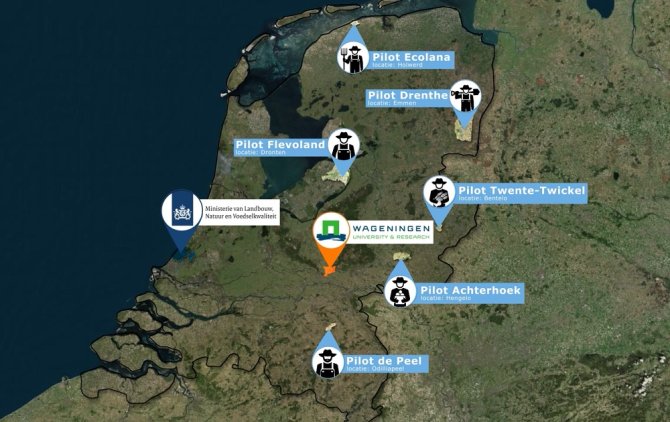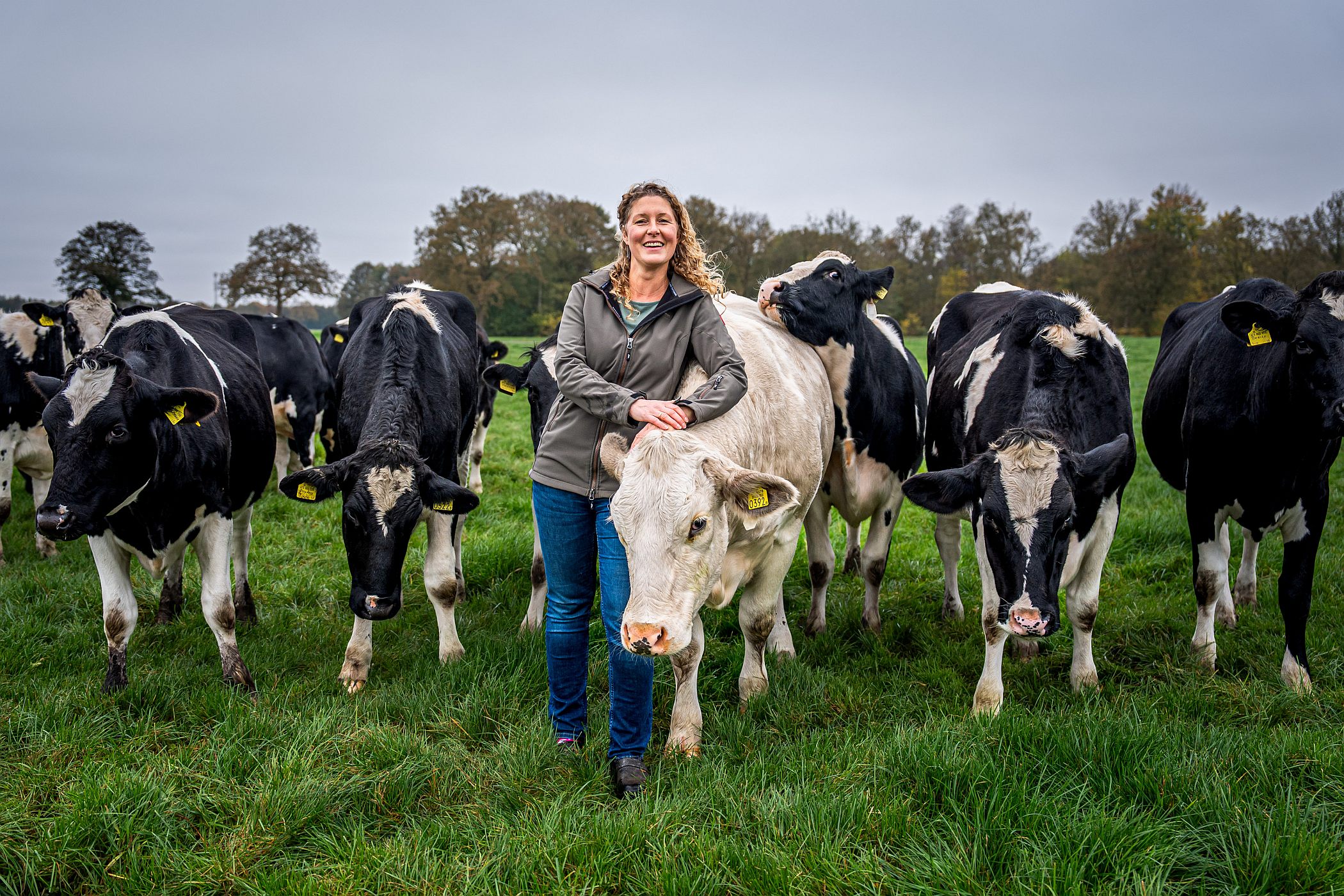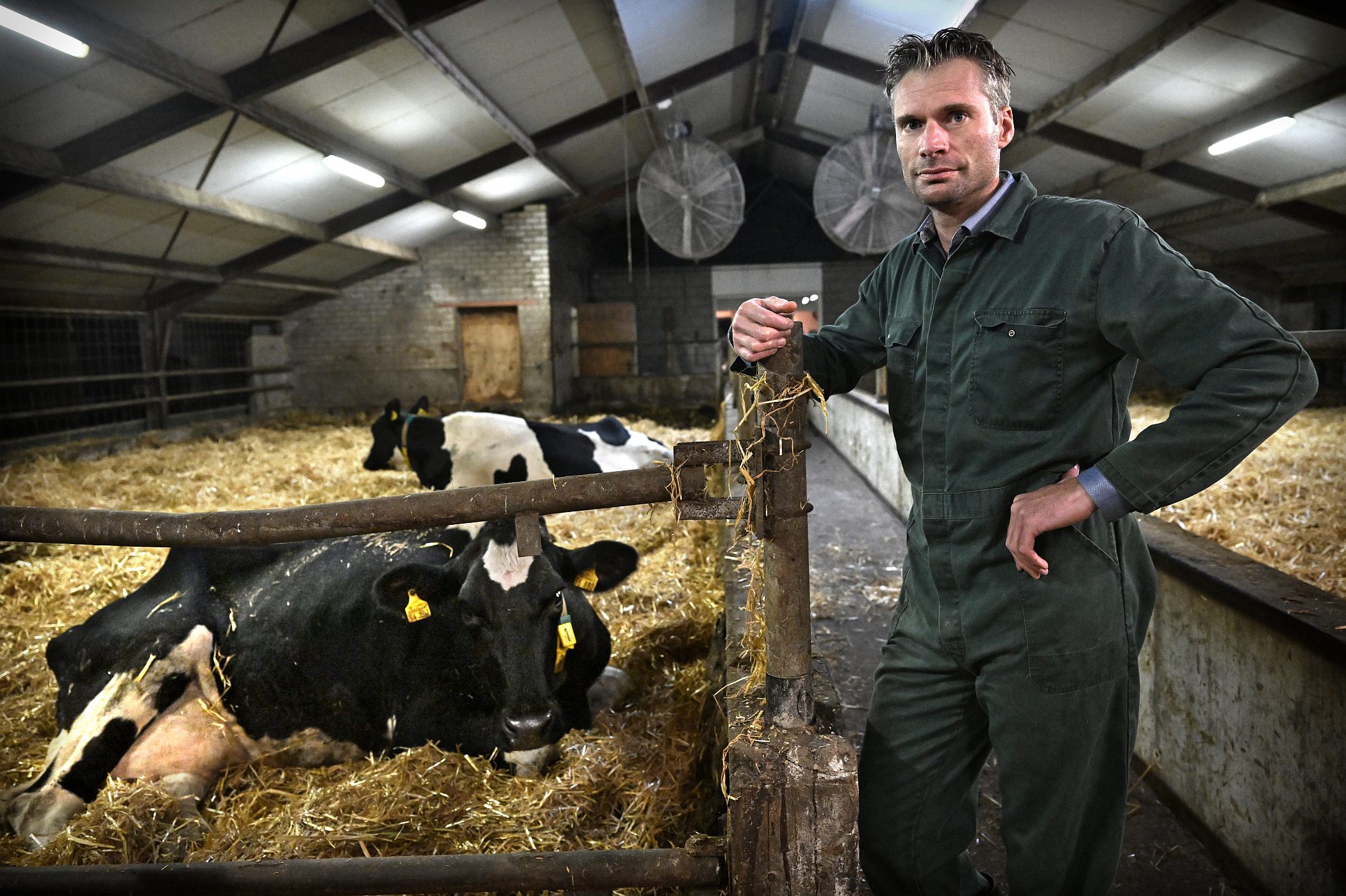
Wageningen World
Closing the cycle with your neighbour
Many Dutch livestock and arable farmers have long collaborated through land exchange. This can benefit nature and the environment, say four farmers engaged in research into their business models. But the results are hard to verify. The aim is target-centred management: environmental targets are set per farm, and the farmers decide how they will reach them.
Giske Warringa from the village of Nooitgedacht in the province of Drenthe has made a map of the farmland in the Netherlands. And she is keen to show it, at the kitchen table at the dairy farm she and her husband Gert-Jan run. On the map, the Dutch farmland is divided into two categories: farmland that gets exchanged between farmers, and land that does not. The map shows that 37 per cent of the farmland does get exchanged. In Drenthe, more than half the land gets exchanged. That swapping of land is one of the ways in which farmers collaborate. ‘But hardly any research gets done on mixed land use,’ says Warringa, disappointedly.
Wageningen World
Warringa, who studied in Wageningen (Animal Sciences 2007), coordinates work in Drenthe on PAVEx: ‘Pilots in collaboration between Arable and Livestock farmers in five Experimental locations for circular agriculture’. This Wageningen University & Research project was born of the policy of minister Carola Schouten, four Agriculture ministers ago. It aims to contribute to closing cycles in agriculture, in the interests of reducing the loss of nutrients, including nitrogen, and minimizing greenhouse gas emissions. In the project, analyses are made of how arable and livestock farmers collaborate. WUR describes the collaborating farming systems and analyses the advantages for achieving the national environmental targets set by the ministry, such as reducing ammonia, nitrate and greenhouse gas emissions, as well as how to prove these environmental benefits .

‘PAVEx aims at clarifying how livestock and arable farmers collaborate, so scientists and government can understand it,’ says Warringa’s colleague in the project, farmer Geertje Enting from the nearby village of Anderen. And much more exchange of land goes on than policymakers and researchers realize, she claims. ‘Sectoral thinking, in which arable and livestock farming are two different worlds, is ingrained in policy at present. We argue for an agricultural policy that takes the soil as its starting point. That’s how we’ve been farming here for years!’ Enting and her husband Albert-Jan run one of the few mixed farms in the Netherlands. They have 140 dairy cows and an arable side to the farm, growing starch potatoes, fodder beets and concentrated feed for the farm’s own cows. They also exchange land with an arable farmer who grows seed potatoes on their land in exchange for fields of new grassland. In addition, they have an agreement with a farmer from the village who grows maize for them and uses their manure on his crops, from which he supplies them in turn with straw. ‘This is very normal; we grew up with it.’
Manure for livestock feed
There used to be a lot of mixed farms in the province of Drenthe. The livestock side of the farm provided the arable side with manure in exchange for livestock feed. Thanks to specialization, mixed farms are now very much in the minority, but collaboration between livestock and arable farmers has continued in the region.

The Warringas in Nooitgedacht exchange land too. They run a dairy farm with 160 cows and 120 hectares of land. They collaborate mainly with their neighbour, arable farmer Tienus Berkepies, who farms on about 170 hectares, growing mainly potatoes but also some fodder beets, grain and onions. The Warringas grow some crops themselves too, including maize and fodder beets – ‘But we let our neighbour grow the beets, because he’s the expert’ – and mixes of barley and peas. ‘We grow 80 per cent of our livestock feed ourselves.’ The collaboration between Warringa and Berkepies is all about crop rotation, whereby a different crop is grown in a given field each year. By swapping fields with a livestock farmer, the crop farmer can grow the same quantity of seed crops every year, and because he grows them on new soils, he has fewer problems with pathogens.
Grass is grown in rotation on exchanged land too. It is feed for the livestock, and serves as a rest crop for the arable farmer. By growing, say, potatoes for a year after four years of grass, the livestock farmer can sow new herb-rich grassland every five years, and will not need to spray the field with herbicide to control weeds. ‘What is more, by using animal manure, the livestock farmer builds up organic matter in the soil, with nutrients that the arable farmer uses afterwards,’ says Warringa. Every winter, they sit down with Berkepies to draw up a new joint crop plan that benefits both parties.
CO2 premium
Warringa supplies milk to the dairy company FrieslandCampina, which has started paying farmers a CO2 premium this year. ‘We score very well on that, whereas we don’t think about CO2 at all. Our aim is to be as selfsufficient as possible and to operate in a regional closed cycle. That’s why, for instance, we buy discarded malting barley locally for livestock feed. That saves us having to buy concentrate, and that keeps our CO2 score low.’
Warringa thinks she farms pretty sustainably, but she is happy to be involved in the PAVEx study. ‘What we show is: arable farmers on sandy soils need grass as a rest crop because grassland fixes organic matter in the soil, boosting its fertility. They can achieve that by sowing the land with grass for a while, and having it grazed by livestock from a local livestock farmer. An additional advantage is that with more organic matter, you retain more water in the soil. And applying this kind of crop rotation means we have fewer diseases and pests in the soil. If we only had grassland on a permanent basis, and our neighbour only had crops on his land, we would both need to spray more pesticide. So we have said: you’re welcome to do research on our farmers, and maybe we will learn from the other four PAVEx areas how to farm even more sustainably.’
Growing vegetables
The PAVEx study on the collaboration between livestock and arable farmers is being run in five experimental regions: North Netherlands, Flevoland, Twente, Achterhoek and De Peel. In De Peel, in the province of Brabant, the project is being coordinated by alumnus Ronald Luijkz (Animal Sciences 1987) innovation manager at Agro Proeftuin Noordoost Brabant. A lot of land exchange goes on in this area too, he says, because it is characterized by a mix of dairy and pig farms, and arable and vegetable growers. Vegetable growers are particularly specialized and need several different fields to keep the supermarkets supplied. So they exchange land with livestock and arable farmers. ‘I hardly know anyone who doesn’t exchange land.’
Exchanging land is also a must for tackling the challenges of farming in North-east Brabant, says Luijkx. ‘There is a lot of manure in the area, where most farmers are located on leaching-prone sandy soils, and we don’t yet meet the nitrate norms for groundwater. Arable farmers need a lot of crop rotation to keep the pressure of disease in crops like potatoes in check, and they can also improve the water quality by alternating intensive crops with extensive ones like grass, on which neighbouring livestock farmers can graze their stock.’
Since 2021, a few of the farmers involved in the project have been measuring how much nitrate is still in the soil in their fields at the end of the growing season, potentially leaching into the groundwater. Nitrate in the soil is a good indicator of both soil and surface water quality, says Luijkx. ‘We are taking measurements in all the fields on Bart Peters’ arable farm and Harm Wientjes’ dairy farm. Between them they have about 200 hectares of land, with a continuous variation in crops, and they can now link the nitrate concentration to the agricultural land use of the past few years. So arable farmer Peters, in Sint Anthonius, with 100 hectares of chipping potatoes, maize, sugar beets and onions, now knows how much nitrate is left in the soil in the autumn. On average, his farm is within the environmental limits. But the situation does vary from one field and crop to the next.
On a field of potatoes and vegetables, the level is generally above the limit, while on a field of beets it is much lower. Peters has noticed that he can also reduce nitrate levels using a fertilization plan and ‘catch crops’ that fix nitrate. Peters’ fertilization plan entails using manure provided by Wientjes, a Wageningen alumnus (Agrotechnology 2006) from nearby Oploo. Wientjes and his brother have an intensive dairy farm: 300 cows on 100 hectares. They collaborate with Peters and two other local arable farmers, who get their manure in exchange for livestock feed, mainly maize. They have a joint farming plan with a five-year cycle of grass, potatoes, beets and two years of maize. This cycle ensures the least leaching of nutrients, says Wientjes. Like Peters, he monitors the nitrate and the phosphate accumulation in the soil.

Methane emissions
But Wientjes’ real showpiece is the manure processing plant on the farm. A manure scraper removes the manure from the barn quickly so that not much ammonia escapes. The manure then goes into a digester, which extracts biogas from it, and the residue goes to a manure separator. The solid waste, which is full of phosphate, gets reused on the farm or sold elsewhere. The liquid waste goes to a ‘stripper’, a machine that captures ammonia in the form of ammonium sulphate, a transparent liquid that can serve as a substitute for artificial fertilizer. What is left is an effluent that is high in potassium and low in nitrogen. This three-stage process reduces methane emissions by 20 per cent and the amount of ammonia on the farm by 70 per cent, says Wientjes.
The figures are based on WUR research. Wientjes provides Peters with the artificial fertilizer substitute and the effluent from his own manure, and under the auspices of PAVEx, Peters has monitored the growth of the field crops fertilised this way. It turns out they grow just as well as they do with artificial fertilizer. A crucial advantage of these fertilizers is that ammonia emissions during application are lower. Wientjes also measures the ammonia concentration in the barn. ‘Then I get a sense of how I could reduce losses even further, for example by removing the manure faster with the scraper.’
Target-driven
This kind of knowledge is useful because research is also being done in PAVEx on whether and how the collaborating circular agriculture farmers contribute to the environmental targets set by the ministry. Like the other PAVEx participants, Wientjes is keen to move towards target-driven management in which targets are set for emissions of ammonia, greenhouse gases and nitrate on each farm. The farmers decide for themselves how they are going to meet these environmental targets. At the moment they sometimes feel hamstrung by nationally imposed blanket rules. One of these is a government ruling that arable harvests should be in by 1 October, after which farmers therefore cannot sow ‘catch crops’ that fix nitrogen in the soil.
This measure is an awkward fit with farming practices, says Bart Peters. The potatoes are not fully ripened by the end of September, and therefore cannot be kept in storage for long. So farmers dig up their potatoes after 1 October and just accept that they will be allowed to apply less manure the next year. Because such measures hamper their farming practices, the PAVEx farmers are keen to move towards target-driven management. Wientjes: ‘Target-driven management gives more incentive to reach environmental targets.’
In Drenthe, Warringa and Enting say the same: ‘Give us environmental targets!’ They want to decide for themselves how they cut their emissions of ammonia, nitrate and greenhouse gases to the target level, by means appropriate for their farming methods. The farmers have another wish too. In the development of target-driven management and the critical performance indicators (CPIs) that go with it, achievements are assessed per farm, says Warringa. ‘We would also like performance indicators that take into account regional nutrient cycles and land exchange. We think the CPIs should start at the field level and then be added up at the farm level.’
CPI for target-driven management
WUR, the Louis Bolk Institute and the consultancy firm Boerenverstand are working on a nationwide system of Critical Performance Indicators (CPIs) for assessing and rewarding sustainability on the farm. In the ‘core set of CPIs for sustainable agriculture’, they describe 13 indicators for dairy and arable farms. The CPIs are intended to play a role in target-driven management. The agriculture sector wants to shift from stipulations about the method, in which the government prescribes specific techniques or methods for achieving environmental targets, to stipulations about targets, which lay down the target or environmental norm, leaving farmers free to achieve them in their own way. Because environmental targets are statutory, target stipulations need to be measurable and enforceable, and supervisory bodies need to be able to hold farmers accountable.
Rich soil life
As an example, livestock farmer Warringa has relatively little permanent grassland, due to the collaboration with arable farmer Berkepies, whereas such grassland is valued highly by Friesland Campina and the Dutch forestry commission Staatsbosbeheer, due to its wealth of soil life and organic matter. Temporary grassland offers other advantages, such as lower levels of pesticide use and many herbs that attract insects, says Warrminga, but you only really see those advantages if you look at crop rotation at the plot level. WUR is currently studying how crop rotation can be integrated into the Critical Performance Indicators.
Within the PAVEx project, research is also being done on how the farmers can demonstrate that they are meeting targets using measurements and data. ‘We need independent measurements and calculations for a legally sound verification of the results,’ says Ronald Luijkx. ‘In recent years, we have learned we need measurements at the plot level. That provides information that can be used to improve cultivation methods, plus we can show the results to the authorities and defend our approach in court.’ ‘A farmer almost needs a university degree to be able to solve the environmental problems,’ jokes Wientjes, himself a science graduate. ‘But if the government is going to set targets per farm, you’ll get study groups forming and farmers will visit their neighbours to ask: how do you go about it?’
Contributing knowledge
And this is where Wageningen contributes useful knowledge, thinks Luijkx. ‘In our region, WUR’s experimental farm in Vredepeel plays an important role. There’s a lot of fundamental knowledge there about the different crops, and farmers are quick to realize that.’ In Drenthe, Warringa gets support from Brenda Timmerman-Pals, a farmer and project leader at WUR’s Farm of the Future in the former peat colony area. Rianne van Zandbrink, a Wageningen researcher who contributes to PAVEx, thinks the project works because it focuses on the participating farmers’ learning goals. ‘The farmers, researchers and policymakers engage in genuine dialogue about what they want to learn from each other. I see that farmers have a collective inventiveness and smart ways of collaborating on things like cutting down on pesticides and concentrates, and that they are inspired by target-driven management.’